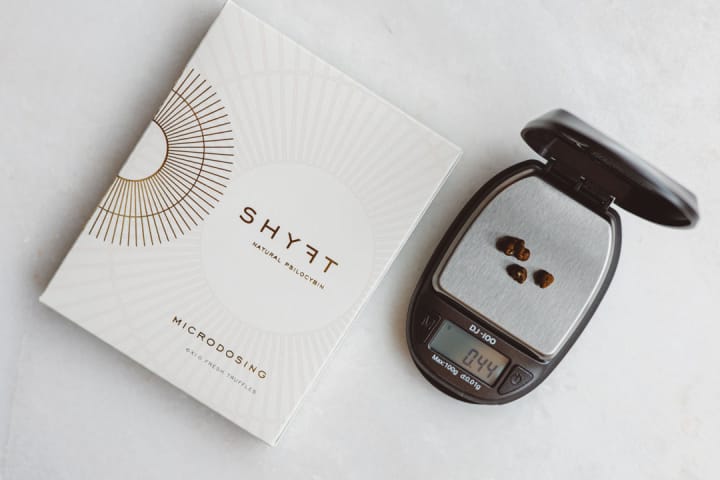
✦ Enjoy free shipping in the Netherlands for orders above €50
It’s in your body, your energy, your thoughts, your motivation. Some days feel grey even when the sun is shining. Others are so overstimulated that even small decisions feel overwhelming.
And if you’re here, reading this, you’re probably not new to the world of natural solutions. Maybe you’ve tried meditation, supplements or journaling. But maybe you’re curious about something different — something that could gently shyft your perspective without numbing you out.
That’s where microdosing comes in.
Microdosing involves taking very small, sub-perceptual doses of psychedelics — often psilocybin-containing truffles. The goal isn’t to “trip” or escape reality. Instead, it’s about creating enough space in your mind and body to experience reality differently. A little lighter. A little more grounded.
Many people describe it as:
💬 “I still feel like me, but less stuck.”
These tiny doses are typically taken every few days (following protocols like Fadiman or Statements – see more on protocols here), allowing the nervous system to rest, reset, and slowly build new patterns.

Both anxiety and depression are closely linked to patterns in the brain. They affect how we process information, relate to others, and even how we perceive time. The brain can become stuck in “loops” of fear, worry, or hopelessness — and often, those loops are reinforced daily without us even noticing.
Psychedelics like psilocybin may help “interrupt” those loops. Studies have shown that even in small amounts, they can:
Increase neuroplasticity, the brain’s ability to create new pathways and adapt (Ly et al., 2018)
Reduce activity in the default mode network, a brain region linked to rumination and self-criticism (Carhart-Harris et al., 2017)
Support mood and emotional balance, with microdosers reporting significantly lower anxiety and depression symptoms than non-microdosers (Anderson et al., 2020)
While clinical research is still evolving, these early findings — and countless personal stories — are bringing new hope to the mental health conversation.
Let’s be clear: microdosing is not a magic fix or a one-size-fits-all solution. But for many people, it opens a door to a gentler relationship with their inner world.
Let’s think about anxiety for a minute, microdosing might not take it away completely but it’ll probably help you stay afloat in the eventuality of meeting it once more.
Practically, how does this look like? You stop being afraid of the moments where anxiety shows up in your system. You might be able to sit with the experience and breathe through it. There’s more space to choose in a previously overwhelming scenario.
That shyft — from panic to presence, from resistance to curiosity — is powerful. And often, it’s enough to start building new habits, showing up in new ways, and reconnecting with the things that make life feel meaningful.

If you’re curious to try microdosing to support anxiety or depression, here are a few things to keep in mind:
Start with intention. Ask yourself: What would I like to shyft or soften? And why? This helps create clarity and consistency.
Choose your protocol. The Fadiman Protocol (1 day on, 2 days off) is a gentle and well-known starting point. More on protocols here.
Track your experience. Journaling your mood, energy, and thoughts can reveal subtle but powerful changes over time. Here’s a free template.
Pair with supportive habits. Breathwork, nature walks, meditation, and therapy all complement the microdosing journey beautifully.
At Shyft, we believe that healing isn’t just about “fixing” what’s wrong — it’s about remembering your wholeness, even on hard days.
You don’t have to push through it alone. If anxiety and depression have made life feel small, microdosing might also support you rediscover your capacity to feel, to hope, and to connect again.
💌 Curious where to start?
Download our free Microdosing Starter Checklist and explore our natural truffle-based microdosing support. Safe, legal, and backed by care.
👉 Get the checklist
👉 Explore our premium truffles
👉 Book a call with a coach
So nice to have you here,
Keep shyfting 🦋
Anderson, T., Petranker, R., Rosenbaum, D., Weissman, C., Dinh-Williams, L., Hui, K., & Hapke, E. (2020). Microdosing psychedelics: Personality, mental health, and creativity differences in microdosers. Journal of Psychopharmacology. Link
Carhart-Harris, R. L., & Friston, K. J. (2017). REBUS and the Anarchic Brain: Toward a unified model of the brain action of psychedelics. Pharmacological Reviews. Link

Joana is a psychology student and wellness enthusiast. She explores the connections between nature, body, and mind, deepening our understanding of how the three can merge to support well-being.